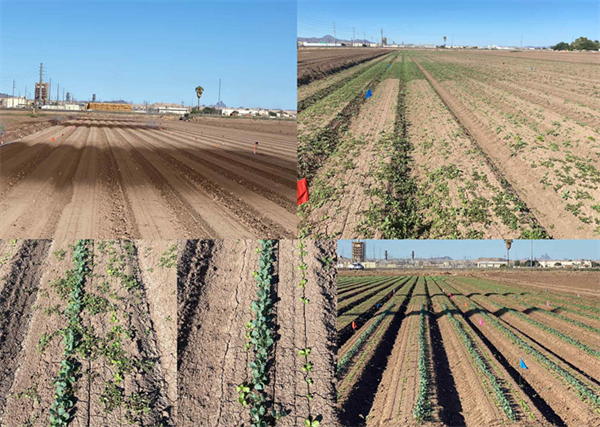Common Purslane (Portulaca oleracea) is a very widespread weed in desert southwest and a problem for vegetable production. At the same time, it is one of the most nutritious leafy vegetables. It has been reported that Common Purslane contains five times higher omega-3 fatty acids than spinach which are important for human growth, development, also prevent of numerous cardiovascular diseases, and maintain a healthy immune system. It also contains vitamins A, B and C and dietary minerals. Common Purslane is consumed in Mexico (Verdolaga), Europe, Asia, and the Mediterranean Region.
Portulaca oleracea can be confused with Horse Purslane but they belong to different families. Common Purslane is in the Portulacaceae family and Horse Purslane (Trianthema portulacastrum) is in the Aizoaceae or Ice plant family1.
One of the IPM strategies for Purslane control in lettuce production is germinating it during ground preparation then kill it with chemicals or tillage. Timing is important because Purslane grows fast and it’s a very prolific seed producer. These seeds can germinate in 12 hours after receiving moisture in August and September. They can also germinate in January and February but will take 3-7 days to germinate at that time. The stems are very succulent and unless they are completely killed and desiccated, they can reroot at the nodes. Tillage that does not completely desiccate the plants can spread rather than eliminate this weed3.
Some herbicides that will kill this weed during ground preparation are Gramoxone, Aim, and ET and systemic (glyphosate) herbicides. Results can range from depending upon weed size, rate and adjuvant used at the time of application. The contact herbicides can produce almost 100% control when the Purslane is less than 2 inches in diameter and less than 50% control when larger than this. Recently we conducted an evaluation in which 2oz of ET with a silicone spreader controlled 100% of the population. According to some researchers control with some contact herbicides can drop from excellent to poor in 3 - 5 days3.
We are evaluating application methods and incorporation timings of Prefar (bensulide) at Yuma Ag Center the and the product continues showing a good performance in controlling Purslane as can be seen in the images below.

Figure 1. Evaluation of bensulide herbicide applications incorporated with sprinkler irrigation.
- Md. Kamal Uddin, Abdul Shukor Juraimi, Md Sabir Hossain, Most. Altaf Un Nahar, Md. Eaqub Ali, and M. M. Rahman (2013) “Purslane Weed (Portulaca oleracea): A Prospective Plant Source of Nutrition, Omega-3 Fatty Acid, and Antioxidant Attribute”
- http://southwestdesertflora.com/WebsiteFolders/All_Species/Aizoaceae/Trianthema%20portulacastrum,%20Desert%20Horsepurslane.html
- https://cals.arizona.edu/crop/vegetables/advisories/more/weed13.html





